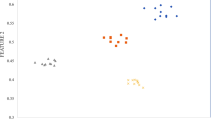Abstract
The aim of this work is to produce a classification system to assess cervical injury from a multi-sensor database. This is a database that has never been gathered before, with data coming from three different sensors: inertial, EEG, and thermography. How well these sensors help to build a good model and which right features influence the response variable are key to a better understanding of the link between sensor data and the presence of a cervical injury. There is an additional data set related to the user/patient (a survey) that will provide us with a different view and a baseline to compare with the sensor data. Both data sets are characterized by few observations and many variables, such that feature selection or feature engineering is crucial to success in building a good classification system. The approach used with both data sets is penalized logistic regression. This type of models helps in the selection of the best features and also prevents overfitting by adding a penalized term over the coefficients in the objective function. To verify the ability of each data set, a k-fold cross-validation was carried out with promising results for both the sensor and survey data sets. Results demonstrate an accuracy of up to 70%, which gives a good starting point to encourage increasing the size of the database with more patients. A final discussion highlights the importance of never underestimating the information provided by the patients.
Access this chapter
Tax calculation will be finalised at checkout
Purchases are for personal use only
Similar content being viewed by others
References
Squires, H., Chilcott, J., Akehurst, R., Burr, J., Kelly, M.P.: Value Health 19(5), 588–601 (2016)
Jones, C.M., Clavier, C., Potvin, L.: Soc. Sci. Med. 177, 69–77 (2017)
de Zoysa, I., Habicht, J.P., Pelto, G., Martines, J.: Bull. World Health Organ. 76(2), 127–133 (1998)
Wang, S., Ding, C., Hsu, C.-H., Yang, F.: Future Gener. Comput. Syst. (2018)
Tao, C., Feng, J.: Comput. Stat. Data Anal. 107, 131–148 (2017)
Forzani, L., García Arancibia, R., Llop, P., Tomassi, D.: Comput. Stat. Data Anal. 125, 136–155 (2018)
Fernández-Cuevas, I., Bouzas Marins, J.C., Arnáiz Lastras, J., Gómez Carmona, P.M., Piñonosa Cano, S., García-Concepción, M.Á., Sillero-Quintana, M.: Infrared Phys. Technol. 71, 28–55 (2015)
Zou, H., Hastie, T.: J. Royal Stat. Soc. Series B 62(2), 301–320 (2005)
Tibshirani, R.: J. Royal Stat. Soc. Series B 58(1), 267–288 (1996)
Acknowledgements
This work has been supported by FEDER and MEC, TEC2016-77791-C4-2-R.
Author information
Authors and Affiliations
Corresponding author
Editor information
Editors and Affiliations
Rights and permissions
Copyright information
© 2020 Springer Nature Singapore Pte Ltd.
About this chapter
Cite this chapter
Font, X., Paul, C., Rodriguez, E. (2020). Data Insights and Classification in Multi-sensor Database for Cervical Injury. In: Esposito, A., Faundez-Zanuy, M., Morabito, F., Pasero, E. (eds) Neural Approaches to Dynamics of Signal Exchanges. Smart Innovation, Systems and Technologies, vol 151. Springer, Singapore. https://doi.org/10.1007/978-981-13-8950-4_41
Download citation
DOI: https://doi.org/10.1007/978-981-13-8950-4_41
Published:
Publisher Name: Springer, Singapore
Print ISBN: 978-981-13-8949-8
Online ISBN: 978-981-13-8950-4
eBook Packages: Intelligent Technologies and RoboticsIntelligent Technologies and Robotics (R0)




